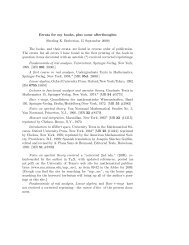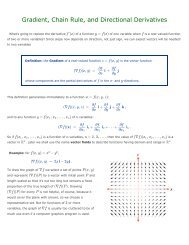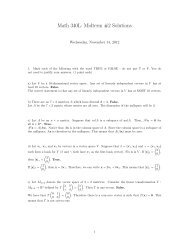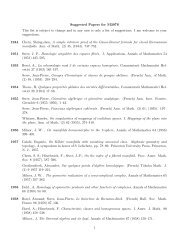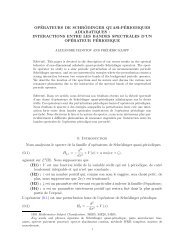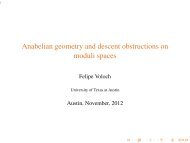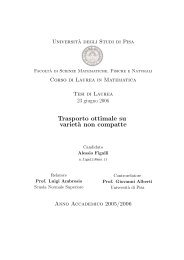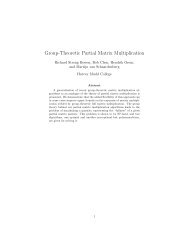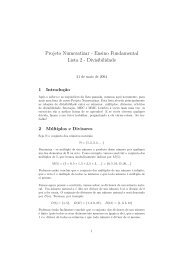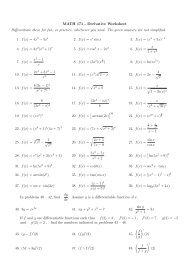Optimal transport, Euler equations, Mather and DiPerna-Lions theories
Optimal transport, Euler equations, Mather and DiPerna-Lions theories
Optimal transport, Euler equations, Mather and DiPerna-Lions theories
Create successful ePaper yourself
Turn your PDF publications into a flip-book with our unique Google optimized e-Paper software.
Chapter 3<br />
<strong>Mather</strong> quotient <strong>and</strong> Sard Theorem<br />
Let (M, g) be a smooth complete Riemannian manifold without boundary, <strong>and</strong> denote by d(x, y)<br />
the Riemannian distance from x to y. For v ∈ TxM the norm vx is given by gx(v, v) 1/2 , <strong>and</strong><br />
we also denote by · x the dual norm on T ∗ M.<br />
We assume that H : T ∗ M → R is a Hamiltonian of class C k,α , with k ≥ 2, α ∈ [0, 1], which<br />
satisfies the three following conditions:<br />
(H1) C 2 -strict convexity: ∀(x, p) ∈ T ∗ M, the second derivative along the fibers ∂2 H<br />
∂p 2 (x, p) is<br />
strictly positive definite;<br />
(H2) uniform superlinearity: for every K ≥ 0 there exists a finite constant C(K) such that<br />
H(x, p) ≥ Kpx + C(K), ∀ (x, p) ∈ T ∗ M;<br />
(H3) uniform boundedness in the fibers: for every R ≥ 0, we have<br />
sup {H(x, p) | px ≤ R} < +∞.<br />
x∈M<br />
By the Weak KAM Theorem it is known that, under the above conditions, there is c(H) ∈ R<br />
such that the Hamilton-Jacobi equation<br />
H(x, dxu) = c<br />
admits a global viscosity solution u : M → R for c = c(H) <strong>and</strong> does not admit such solution<br />
for c < c(H). In fact, for c < c(H), the Hamilton-Jacobi equation does not admit any viscosity<br />
subsolution. Moreover, if M is assumed to be compact, then c(H) is the only value of c for which<br />
the Hamilton-Jacobi equation above admits a viscosity solution. The constant c(H) is called<br />
the critical value, or the Mañé critical value of H. In the sequel, a viscosity solution u : M → R<br />
of H(x, dxu) = c(H) will be called a critical viscosity solution or a weak KAM solution, while<br />
a viscosity subsolution u of H(x, dxu) = c(H) will be called a critical viscosity subsolution (or<br />
critical subsolution if u is at least C 1 ).<br />
35



